[p. 2-7]
A collective of individuals
“The further development of socialist collectivity is impossible without the comprehensive development of the individual, without the unveiling of the richness and uniqueness of each personality. The wisdom of the current stage of social development teaches us that the brighter the personality, the higher the level of development of each member of the collective, and the more capable and humane the collective is in its social quality.
The Oblast Scientific and Methodological Center for Folk Art and Cultural and Educational Work has succeeded in creating such a collective. It is known as the Volyn Amateur Film Studio. The example of this association clearly demonstrates how the aspirations of each member to improve and express themselves can seamlessly merge with the interests of the entire collective, how the individual qualities of amateurs become collective assets, and how they shape the creative identity of the studio as a whole.
The studio’s distinctive style is characterized by the exploration of challenging topics, synthesis of emotions and reflections, vibrant visuals, and unconventional cinematic solutions—all of which formed the cornerstone of its creative output and lent its films undeniable authority.
The truly creative endeavors of the amateurs commenced with the film In the Yard of the Black Hermit [В обійсті чорного самітника]. The depiction of nature, the portrayal of the world’s transformation according to the principles of humanity, beauty, and the genuine truth of life—these themes, which took center stage in the work, established the cohesion between the social and artistic approaches of its creators in capturing reality on screen. It seamlessly blended journalism and lyrical elements with a profound understanding of nature and the intricacies of the human soul.
The Light of the Vytiaz [1][Світло витязя] marked a significant milestone on this journey. It embodies, perhaps, all the most expressive qualities of the filmmakers from Lutsk: the emotional depth of the film narrative, the inclination towards exploring challenging issues, and the utilization of new expressive techniques, including experimental ones.
“It seamlessly blends the artistic techniques of cinematic storytelling with documentary footage, poetic observations, and scenes of grotesque humor,” remarks the renowned film critic and director of Ukrtelefilm studio, H. Desiatnyk. The creators of this color film successfully intertwine legendary history with the contemporary beauty of the lake and its environmental challenges.
The studio’s proficiency continued to grow, and the images evolved not as isolated, scattered discoveries, but as a cohesive, molten casting. The journalistic film essay May Spring Always Bloom [Хай завжди квітує весна] stands as evidence of this progression. Viewers likely noted how the creators delved deeply into the psychology of the protagonist and made significant insights. The inspiration for this character was Hanna Oleksandruk, a member of a flax-bearing unit from the Starovyzhiv district, an individual of remarkable determination who endured and triumphed over a serious illness, ultimately becoming an asset to society. The filmmakers not only succeeded in unveiling her inner world but also elevated their narrative to encompass artistic and philosophical reflections on courage, kindness,
The thematic depth of these films is remarkable. Drawing from documentary material, they offer rich and meaningful insights into the lives and endeavors of communists (Volyn: From Congress to Congress [Волинь: від з’їзду до з’їзду]), the resolution of economic challenges (Lutsk—Quality Boundaries [Луцьк — рубежі якості], Improvement is Everyone’s Business [Впорядкування — справа кожного], Heroes Among Heroes [Герої серед героїв]), the cultivation of patriotism and opposition to class adversaries (The Unearthed Well [Розкопана криниця]), and the enchanting allure of folk traditions (Karpyliv Vechornytsi [2] [Карпилівські вечорниці]).
Recently, the students have expanded their horizons beyond local subject matter in search of new themes. During their vacations and occasional business trips, they have ventured to the Baltic States, Belarus, Central Asia, and various regions of the Russian Federation. Each journey has served to enrich their creativity and inspire new topics. For instance, the film Putorana Country [Країна Путорана] emerged from their experiences in the northern tundra near Norilsk. Dixon island provided captivating scenery for the film 81st Parallel [81-а паралель], while the Białowieża Forest complemented the narrative of The World of the Vytiaz,[3] centered around the Volyn lake Svityaz.
Establishing creative connections with studios in neighboring oblasts broadens the horizons of artistic thought. Residents of Lutsk have had multiple encounters with amateur filmmakers from Rivne, Ternopil, Mohyliv, Brest, Chisinau, and Dnipropetrovsk, carefully studying their experiences. These encounters have provided ample opportunities for the exchange of ideas and knowledge with the people of Volyn. Such journeys and direct interactions not only foster cinematic creativity but also facilitate mutual enrichment, fostering a healthy competition that actively contributes to the advancement of the amateur film movement.
A solid material foundation for the film studio plays a crucial role in expediting the creative process and bringing ideas to fruition. It is the facilities of Volyn studio that draw visitors’ attention. The 160-square-meter building accommodates a 60-seat screening room, a director’s room, a camera booth, a film projection room, a voice-over recording pavilion, a film processing laboratory, a technical workshop, and a library. To add, the library houses not only literature on film and photography but also numerous phonograph records used for film dubbing. The former basement underwent a transformation thanks to the efforts of the studio staff and with the assistance of local organizations.
The Department of Culture contributed a lot to the technical equipment of the studio. The studio has modern film cameras, tape recorders, projection devices, automatic overhead projectors, and a wide variety of laboratory equipment.
All this helps to create films at a professional level. It will be useful to list the films of the Volyn Film Studio that have won awards:
International
The World of the Knight
Karpyliv Vechornytsi
All-Union
In the Yard of the Black Hermit
May Spring Always Bloom
The First Night [Перша ніч]
The Unearthed Well
The Wizard of Lutsk [Чарівника із Луцька]
Republican
The Melody of the Cutter [Мелодія різця]
Putorana Country
These Difficult Seconds [Ці важкі секунди]
To Overcome Oneself [Перебороти себе]
Volyn: From Congress to Congress
The Enchanted Circle [Зачарований круг]
Certainly, these award-winning films speak volumes about the studio’s prowess. They represent the studio’s prized collection, marking milestones along the creative journey of the entire collective. Just as a mighty river is formed by the merging of tributaries and streams, the achievements of this collective are the result of the contributions made by each of its members. The brighter the personality, the more significant their contribution to the collective creative endeavor. Hence, it would be fitting to summarize the collective experience and highlight individual members of the studio.
A film is always a synthesis of myriad emotions and reflections. Even a film crafted for a specific occasion carries with it the life experiences accumulated by its creators over the years. “Volyn” brings together precisely such individuals.
Consider the studio’s director, Borys Revenko, for instance. He first picked up a camera at the age of sixteen and embarked on a journey that led him to work in the Far East on a Komsomol ticket. For thirteen years, he sailed on the whaling flotilla “Soviet Russia,” serving in various roles including sailor, harpooner, dismantler, and winchman. Additionally, he organized and led the “Antarctica” photo club on the flotilla for seven years.
Cinematographer Omelian Ivaniuk brought a wealth of life experience to the studio. He began his journey with photography during his school years and continued his passion in a club at the Rozhyshche District House of Culture. He further refined his skills during his military service and later organized a film club at one of the vocational schools in Lutsk, where he first became acquainted with the Volyn Studio.
This list can be extended further. Volodymyr Skvortsov, Ronald Valiayev, and Volodymyr Boyko have made significant contributions to the studio’s work. Its achievements would be unimaginable without the creative insights and initiative of individuals such as Yosyp Strutsiuk, Volodymyr Antoniuk, Yaroslav Pavlovsky, Borys Suprunchuk, and many others. In total, the studio brings together nearly forty enthusiasts for whom cinema is not just a passion or a hobby, but a vital necessity.
The dynamic and exploratory atmosphere serves as fertile ground where the seeds of experience and initiative sprout into creative discoveries. Here, amateurs acquire skills, develop and refine their abilities, and broaden their horizons of thought and worldview. Hence, it is no exaggeration to refer to a film studio as a kind of school or a talent forge. Here are a few examples to illustrate this point.
Several former studio members have transitioned into professional roles. Vasyl Ivanyuk currently works as a cameraman at the Lennaukfilm studio. Serhiy Tyshkevych has aligned his career with the Krasnoyarsk studio of documentary and chronicle films. Yevhen Nazaruk took charge of the slide club at the regional inter-union House of Amateur Art.
“Volyn” has provided numerous students with the opportunity to establish amateur studios in cities and districts across our region. For instance, Yosyp Strutsiuk established a film association at the Kivertsi District House of Culture, Borys Suprunchuk at the Lutsk Cardboard and Roofing Board Plant, Volodymyr Antoniuk in Liubertsy, Moscow oblast, and Vasyl Riabunets in Rivne. Their films have already garnered attention from audiences, indicating that these studios have selected and nurtured the best talents.
And “Volyn” is embarking on a new quest. In celebration of the 70th anniversary of the Great October Revolution, members have prepared a series of films showcasing their progressive journey in their craft. One cannot watch the film We Are Echoes, We Are Memory [Ми — відлуння, ми — пам’ять], depicting the heroic act of Yuriy Leliukov, a teacher at Ivanichi Secondary School No. 2, without being deeply moved. The soul is enriched when watching My Strange City [Дивне місто моє], and a greater sense of responsibility for environmental stewardship is instilled by The Thirsty Breath of the Earth [Спраглий подих землі].
These and other films vary in subject matter, genre, themes, and direction. However, they share common elements: journalistic integrity, emotional depth, and unconventional approaches. These elements serve as the catalyst for new creative discoveries.
Cinematography holds tremendous power over those it touches, and “Volyn” enthusiasts are captivated by it.”
Notes
[1] Brave warrior, hero, bogatyr; used mainly for Kievan Rus’ warriors in the pre-Mongol period. In foreign language literature, the term “knight” is often utilized to convey similar concepts in relevant contexts.
[2] Ukrainian traditional gatherings with music, songs, jokes, and rituals.
[3] In the Ukrainian version of this text, an error was made by the authors who mistakenly wrote “World” [Світ] instead of the correct “Light” [Світло]. Given that this film is dubbed in Russian, it is plausible that the confusion arose during translation to Ukrainian due to the phonetic similarity between “світло” (light) and “світ” (world) in Ukrainian. Alternatively, it is possible that the authors, potentially engaged solely to produce a propagandistic brochure, never actually watched the film, resulting in this oversight.


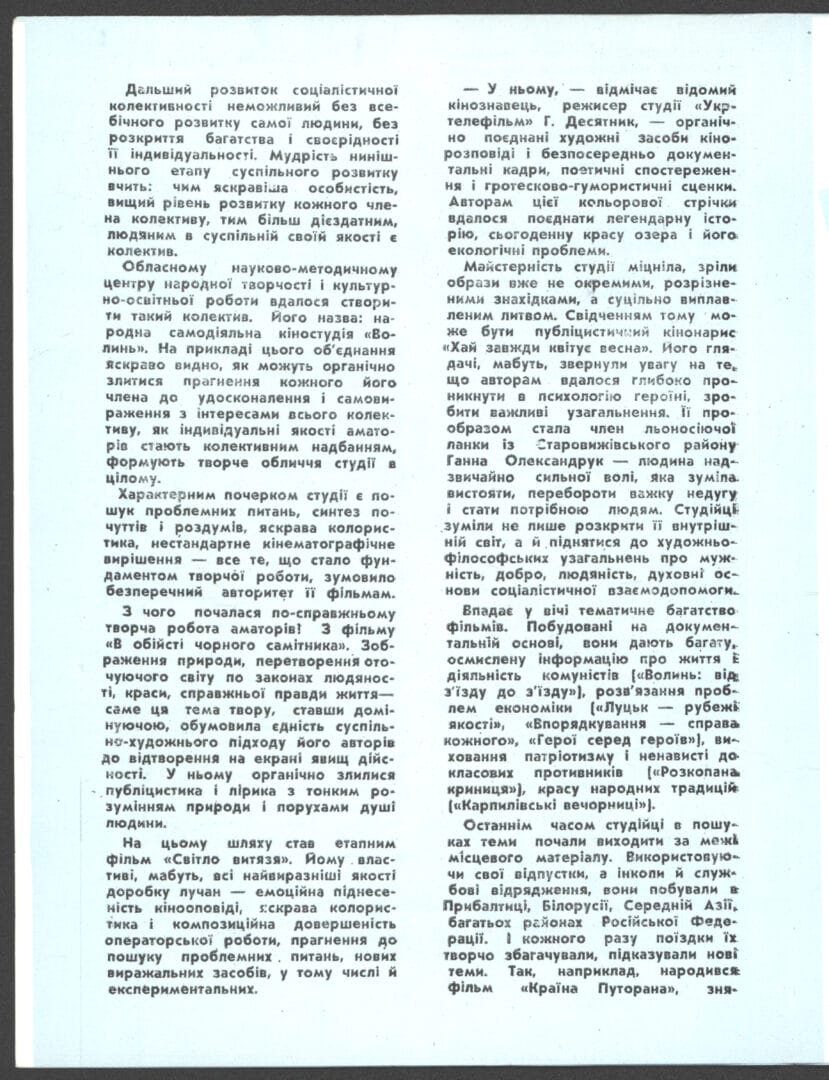

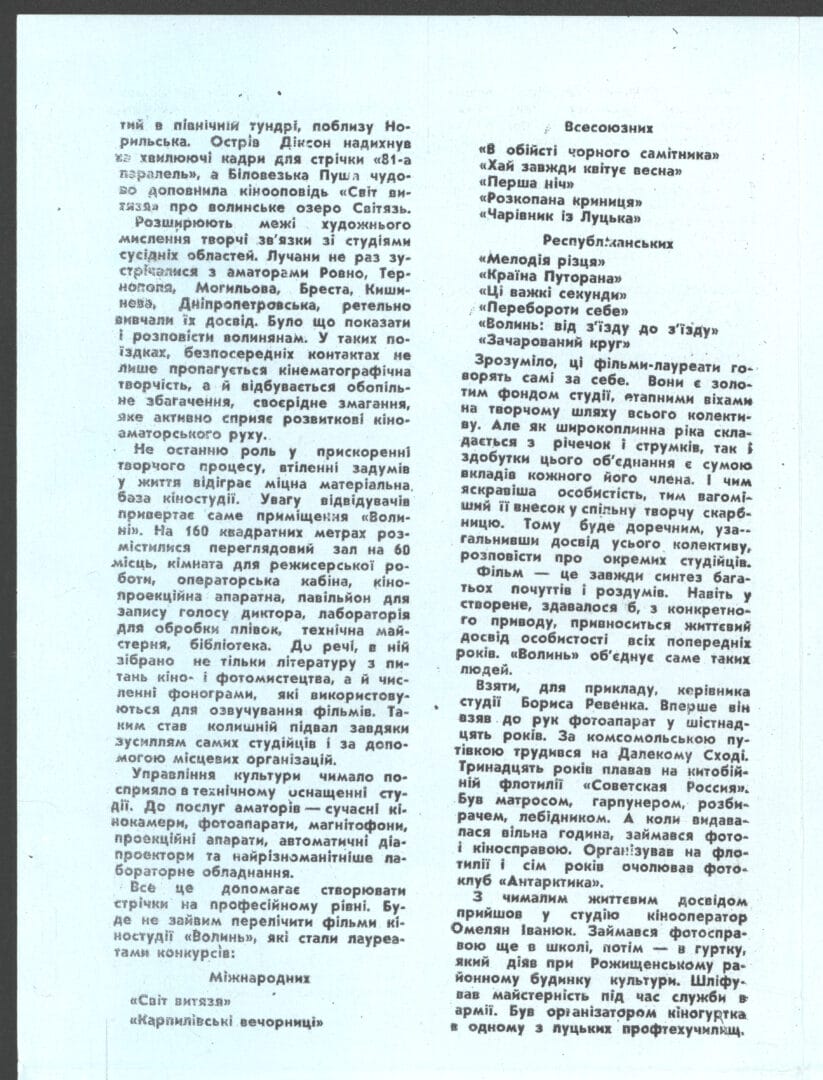
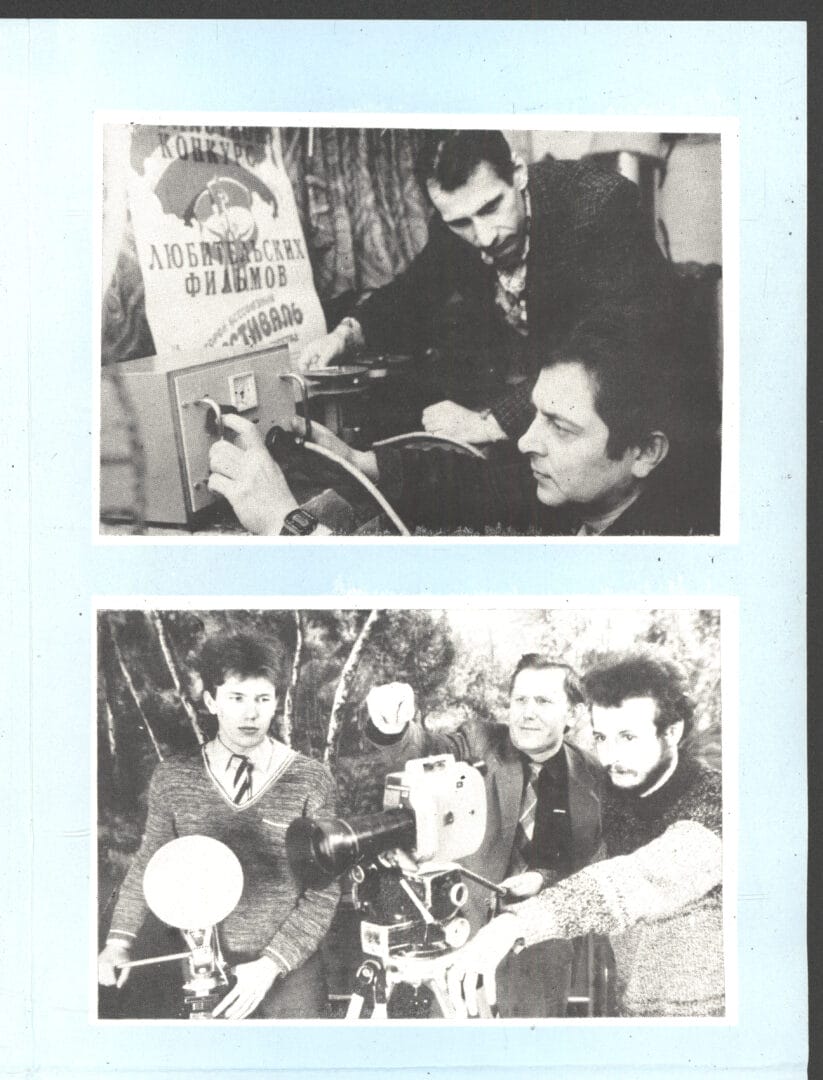

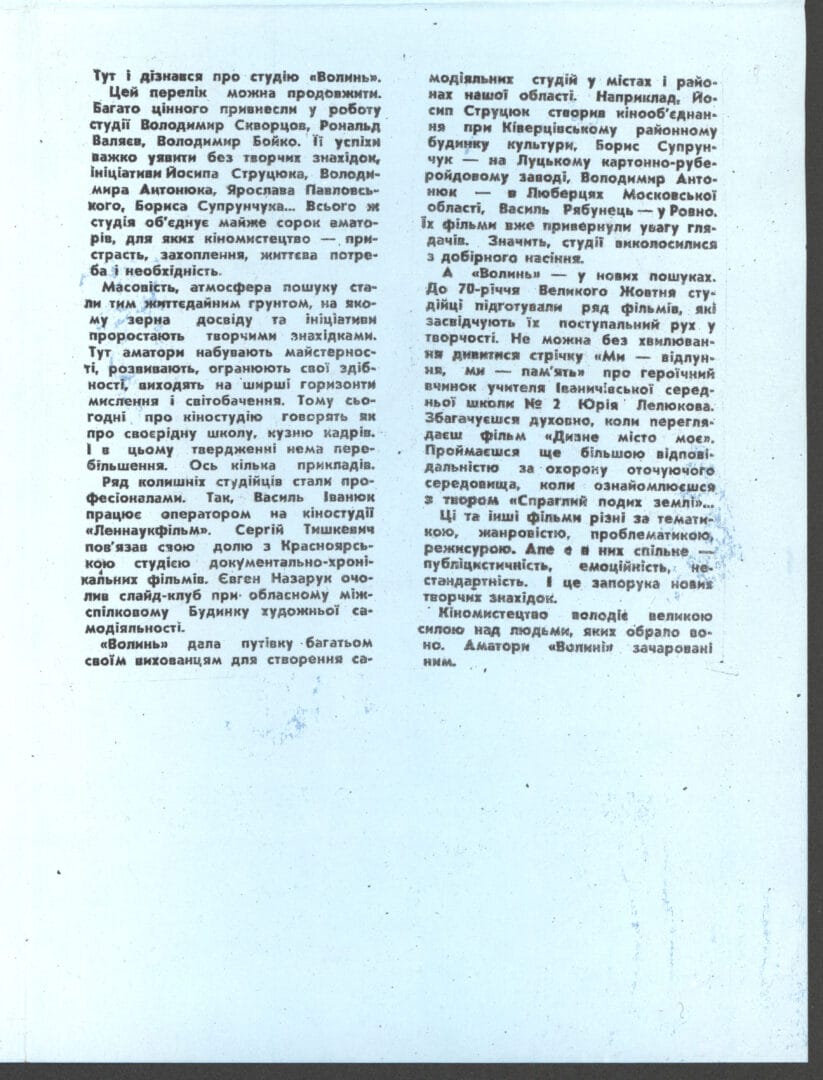
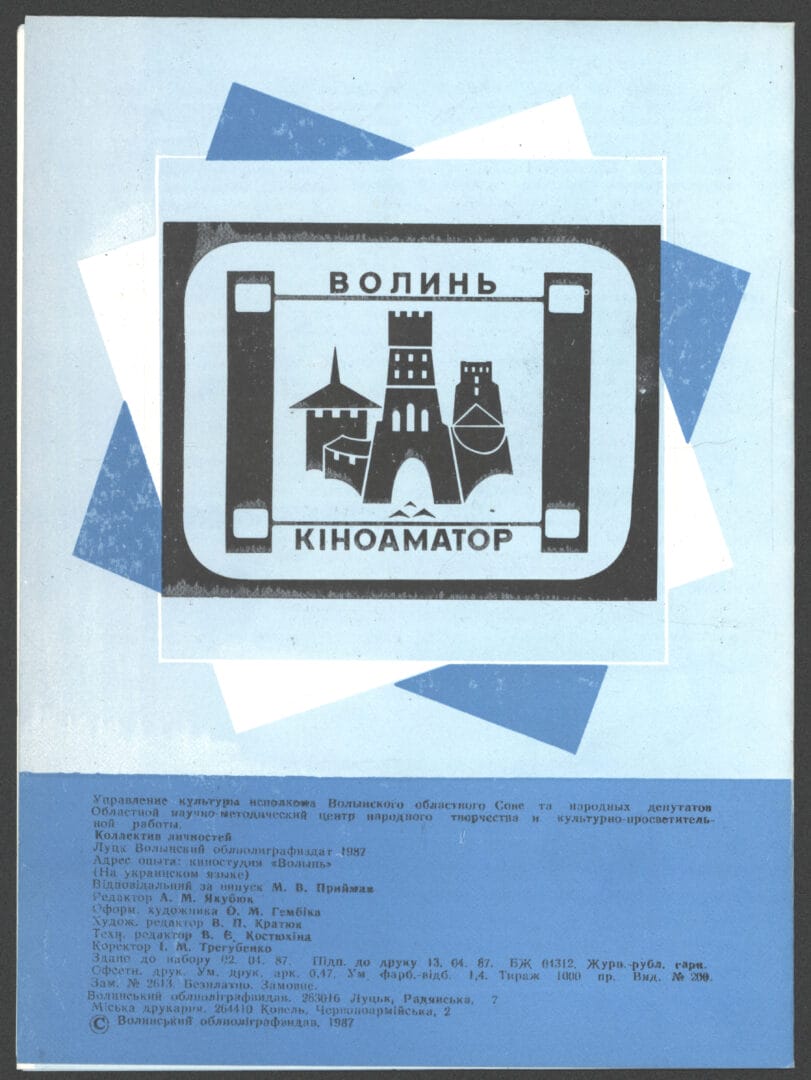
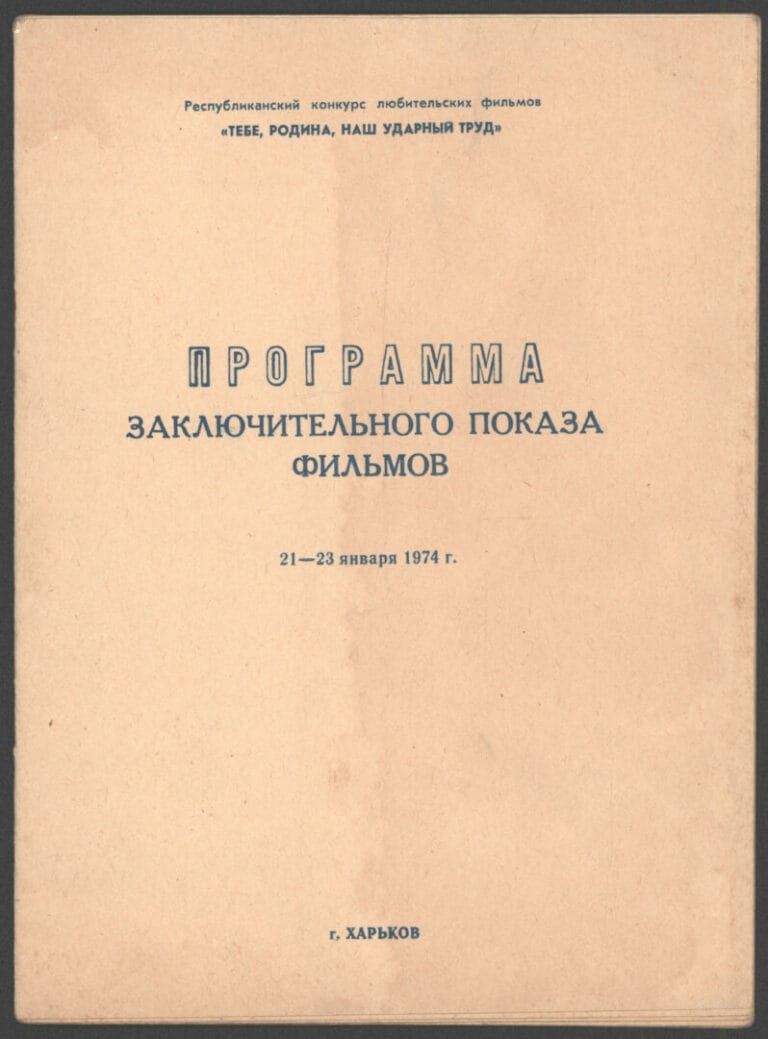

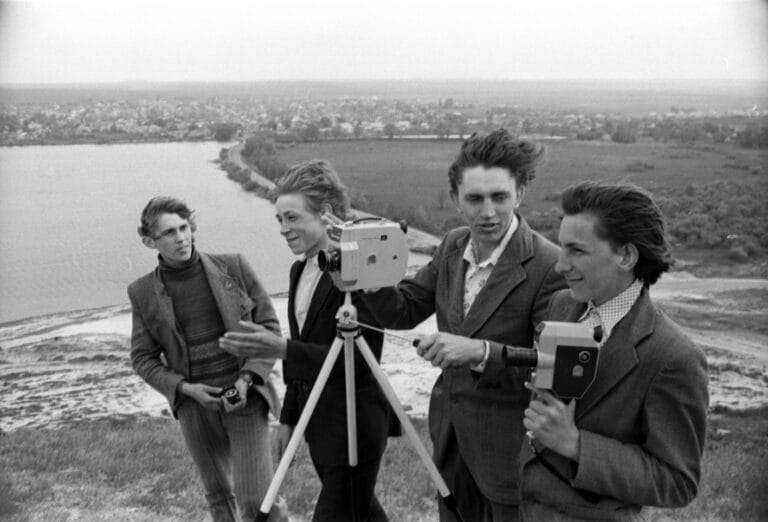

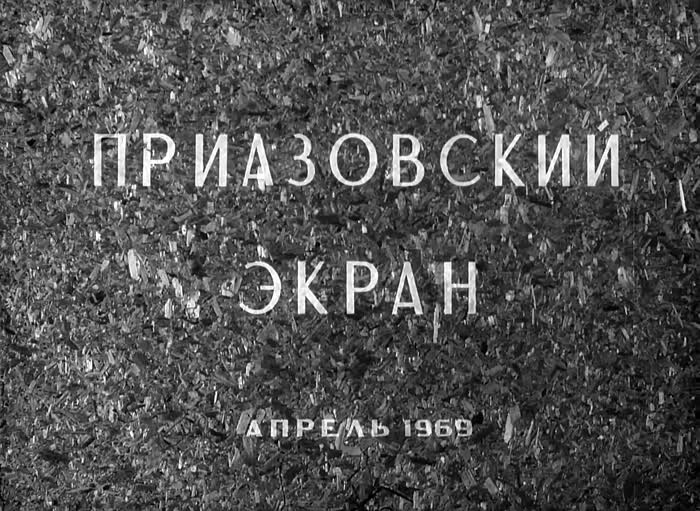
The source provided below is a promotional booklet from the Soviet amateur film studio “Volyn,” located in Lutsk. Unlike studios that were under the authority of and funded by trade union organizations, this studio was affiliated with the oblast department of culture. The booklet highlights the achievements and activities of the studio. This type of publication was widely circulated and exchanged at competitions and festivals of various levels. The presence of such printed materials could further indicate the level of financial support for the studio.